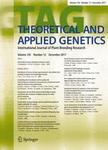版权所有:内蒙古大学图书馆 技术提供:维普资讯• 智图
内蒙古自治区呼和浩特市赛罕区大学西街235号 邮编: 010021

作者机构:Univ Tokyo Lab Biometr Div Agr & Life Sci Bunkyo Ku Tokyo 113 Japan Washington State Univ Dept Crop & Soil Sci Pullman WA 99164 USA
出 版 物:《THEORETICAL AND APPLIED GENETICS》 (Theor. Appl. Genet.)
年 卷 期:1998年第97卷第1-2期
页 面:293-298页
核心收录:
学科分类:0710[理学-生物学] 07[理学] 09[农学] 071007[理学-遗传学] 0901[农学-作物学] 0902[农学-园艺学] 090102[农学-作物遗传育种]
主 题:distorted segregation molecular marker recombination value maximum-likelihood method EM algorithm
摘 要:Distorted segregation has been repeatedly observed in various plant species in molecular-marker linkage mapping where distant crosses were made. It may be caused by a partial lethal-factor acting in the filial generations. A method is presented for estimating the recombination values between a partial lethal-factor locus and a linked molecular marker and the relative viability or fertilization ability of zygotes or gametes, respectively affected by the partial lethal factor in backcross (BC) and doubled-haploid (DH) populations using the maximum-likelihood method associated with the expectation maximization (EM) algorithm. The method was applied to segregation data of molecular markers for a population of 150 DH lines developed from the Steptoe x Morex cross in barley. The presence of a partial lethal-factor locus, located on chromosome 4, causing partial selection was suggested. This locus was tightly linked to the ABG500B marker, and the chance of fertilization of female gametes possessing the partial lethal factor was, on average, 59.8% that of a normal one. Two additional partial lethal factors were found on chromosome 5.